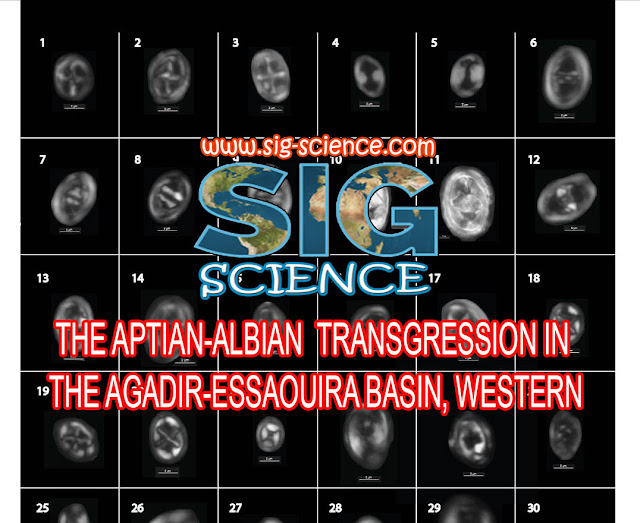The Aptian-Early Albian intervalof the southern Tethyan margin is poorly understood since sedimentary successions are frequently incomplete and dating is difficult.The Essaouira-Agadir Basin (EAB), Morocco,presents numerous, very good and accessible outcrops of theEarly Cretaceous series.The aim of this work isto(1) establish an integrated stratigraphic framework of the Aptian-Albian seriesbased on(a)high-resolution ammonites and calcareous nannofossil biostratigraphy, (b) identification of sedimentary discontinuitiesand (c) carbon isotope stratigraphy;(2) reconstruct the paleoenvironmental evolutionduring this interval through both sedimentary facies evolution andqualitative and quantitative nannofossil analyses, and(3) propose a functioning model for the sedimentation on the mixed, carbonate/clastic ramp of the EAB.
In the EAB, theLate Barremian is defined by the sarasiniammonite zone and the NC5 nannofossil zone.TheBarremian/Aptian boundaryis defined by ammonites.TheEarly Aptian is defined bythedeshayesi tofurcata ammonite zones,and is bounded by afirst minimum13C value at the base and afirst maximum value at the Early/Late Aptian Boundary.TheLate Aptian interval, is defined by four ammonite zones (martini, melchioris, nolaniand jacobi),two discontinuity surfaces, fourmaximum and minimum 13C values,andby the upper part of the NC6, the NC7 and the lowermost part of the NC8 nannofossil zones.TheAptian/Albian boundaryis placed within the discontinuity D4(base of the Leymeriella tardefurcataammonite zone),supported by the First Occurrence (FO)of thePrediscosphaera columnataand Hayesites albiensisnannofossil taxa,andby decreasing 13C values.Early Albian timesarerepresented by the tardefurcataand mammillatumammonite zones, the FOof Hayesites albiensis,andby minimum 13C values.
The facies and depositional environments of the Aptian-Early Albian rocks are identified basedontheir lithology,sedimentary structures,fossilcontentandmicrofacies.
These allowed to identify (1) four types of key surfaces relatedsubaerial orsubmarine erosion, (2) foursedimentarycarbonatedfaciesin the Aptian corresponding to outer to inner ramp depositional environments,and (3) four Early Albian sedimentaryfacies, represented by sandstones and shales, ofbasin to middle ramp depositional setting. These facies reflectdepositioninadjacentandgradational paleoenvironments.
The Aptian-Early Albian stratigraphic intervalof the EAB,has been subdivided into two majorcycles, floored by two major erosional surfaces. The latest Barremian-Aptian cycle is underlined by a major karstified-erosional surfaceand consists of four third-order depositional sequences.The Early Albian cycle, overlies a major submarine erosional surface, and also contains four depositional sequences. In each cycle, the vertical changesin faciesindicates a deepening upward trend related to sea level rise. The carbonate production in the EABis higher in the Aptian than during the Early Albian, due to warm conditions, slow rise of sea level, shallow depth of the basin, and little detrital influx.The nannofossil total absolute abundance decreases from the Aptian to the Early Albian, due to increasing sedimentation rate, associated with rapid subsidence.The nutrient input, fertility and calcareous nannofossil primary productivity is higher in the Early Albian with respect to the Aptian, and are mainly controlled by rising sea level and upwelling currents.The Latest Aptian-Early Albian period is characterized bya high abundanceof cold taxa, and the migration of cosmopolitan biota from Boreal realm into the Tethyan realm, which may reflect the occurrence of a glacial climatic event.
Read and download
Follow us on Facebookh




















